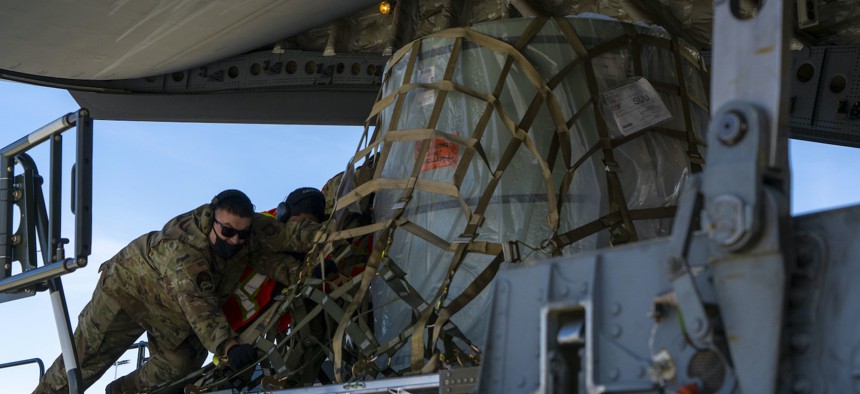
Airmen load cargo onto a C-17 Globemaster III at Joint Base Elmendorf-Richardson, Alaska, May 1, 2021, during an exercise. U.S. Air Force / Senior Airman Adriana Barrientos
Can AI reduce Air Force logistics planning from days to minutes?
Air Mobility Command is testing a new tool that might help in a Pacific conflict.
The U.S. Air Force’s Air Mobility Command is testing a new tool that uses artificial intelligence to plan moves as the Pentagon grapples with tough logistics challenges in the Pacific.
The cloud-based tool, called Artiv, promises to complete “highly complicated operational wargaming analysis” in minutes instead of days, said Col. Bradley Rueter, who leads the command’s Commander’s Initiative Group.
Built by DEFCON AI, Artiv aims to streamline logistics missions, allowing Air Force planners to compare different courses of action if there’s a disruption, such as an enemy attack or natural disaster.
“Because that feedback happens so quickly, it allows our planners to adjust before we start executing,” Rueter said.
Artiv is just one part of an “ecosystem” of integrated operational planning tools that AMC is developing to predict where the command’s services will be needed, Rueter said, adding that the tools will “succeed together and fail together, and hinge upon organizational change within the headquarters.”
Rueter said the larger network is on track to deliver “revolutionary” operational planning capabilities in 2025.
Scott Stapp, DEFCON’s chief technology and revenue officer, said Artiv could be used to quickly adjust if an aircraft unexpectedly is grounded or needs maintenance and the command can’t move supplies as planned.
“With as many variables, as many bases, as many load-outs, and as many aircraft, it can be a multi-day planning effort. This shrinks it down to 20 to 30 minutes as you populate it with variables you want to ensure that the logistics flow as efficiently as possible,” Stapp said. “It allows the user to decide, do they want it to be the most cost-effective, do they want to have the best time for logistics to arrive so they have the least delayed loads?”
“Right now, a lot of it is truly just planners going through whiteboards looking at how they do this stuff over several days. If you have major disruptions, you don't have time to do that over seven days and so it's really giving them tools to make decisions,” he said.
Stapp said the company plans to add more complex AI tools to future iterations of Artiv, but that will require more data from the Defense Department. A lot of data is required to successfully employ AI, Stapp said, and the department is typically reluctant to hand that over until it has worked with the company.
“I think where we want to grow this tool over time, is if you put it in a conflict as we start to be able to get data from the department on analyzing basically red information, how is your adversary behaving? What are they doing? You can start using AI to do predictive analysis on the next move so you can…plan what is the best next move in logistics,” he said.
Figuring out “contested logistics”—that is, moving supplies across vast Pacific distances during a conflict—is a Pentagon-wide effort.
Stapp said contested logistics is a gigantic piece of Joint All-Domain Command and Control, the Pentagon’s effort to streamline communication and share information between the department’s military assets across air, land, sea, and cyberspace.
“It goes back to—you can't fight if your logistics did not flow to the right places, so doing that fast, doing that efficiently, is absolutely critical. This tool is, I think, a key to doing that,” he said.
DEFCON was publicly launched in 2021 by Red Cell, a venture capital firm that “backs, builds, and scales early-stage technology-led companies in healthcare and national security.”


